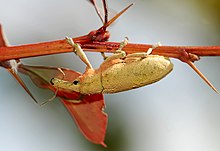Curculionidae: Difference between revisions
m Dating maintenance tags: {{Dead link}} |
Stemonitis (talk | contribs) fix dead link; format ref.; etc. |
||
| Line 7: | Line 7: | ||
| subdivision = |
| subdivision = |
||
}} |
}} |
||
'''Curculionidae''' is the [[family (biology)|family]] of the "true" [[weevil]]s (or "snout beetles"). It was formerly recognized in 1998 as the largest of any [[animal]] family, with over 40,000 species described worldwide at that time.<ref>{{cite web | url = http://entomology.ifas.ufl.edu/foltz/eny3005/lab1/Coleoptera/Curculionid.htm | author = John L. Foltz | title = Coleoptera: Curculionidae|year=1998 |
'''Curculionidae''' is the [[family (biology)|family]] of the "true" [[weevil]]s (or "snout beetles"). It was formerly recognized in 1998 as the largest of any [[animal]] family, with over 40,000 species described worldwide at that time.<ref>{{cite web | url = http://entomology.ifas.ufl.edu/foltz/eny3005/lab1/Coleoptera/Curculionid.htm | author = John L. Foltz | title = Coleoptera: Curculionidae|year=1998 |archiveurl=http://web.archive.org/web/20100829172620/http://entomology.ifas.ufl.edu/foltz/eny3005/lab1/coleoptera/Curculionid.htm |archivedate=August 29, 2010}}</ref> Today, it is still one of the largest known. |
||
==Description== |
==Description== |
||
| Line 17: | Line 17: | ||
==Phylogeny== |
==Phylogeny== |
||
The [[phylogeny]] of the group is complex; with 40,000 species there is a spirited debate about the relationships between subfamilies and genera. A 1997 analysis attempted to construct a phylogeny based mainly on larval characteristics.<ref>{{cite |
The [[phylogeny]] of the group is complex; with 40,000 species there is a spirited debate about the relationships between subfamilies and genera. A 1997 analysis attempted to construct a phylogeny based mainly on larval characteristics.<ref>{{cite journal |author=Adriana E. Marvaldi |year=1997 |title=Higher level phylogeny of Curculionidae (Coleoptera: Curculionoidea) based mainly on larval characters, with special reference to broad-nosed weevils |journal=[[Cladistics (journal)|Cladistics]] |volume=13 |issue=4 |pages=285–312 |url=http://www.cricyt.edu.ar/entomologia/Articulos/Cladistics13%281997%29.pdf |format=[[Portable Document Format|PDF]] |doi=10.1111/j.1096-0031.1997.tb00321.x}}</ref> |
||
== See also == |
== See also == |
||
| Line 36: | Line 36: | ||
{{wikispecies}} |
{{wikispecies}} |
||
On the [[University of Florida]] / [[Institute of Food and Agricultural Sciences]] ''Featured Creatures'' website: |
On the [[University of Florida]] / [[Institute of Food and Agricultural Sciences]] ''Featured Creatures'' website: |
||
* [http://entomology.ifas.ufl.edu/creatures/veg/beetle/pepper_weevil.htm |
* [http://entomology.ifas.ufl.edu/creatures/veg/beetle/pepper_weevil.htm ''Anthonomus eugenii'', pepper weevil] |
||
* [http://entomology.ifas.ufl.edu/creatures/veg/potato/sweetpotato_weevil.htm |
* [http://entomology.ifas.ufl.edu/creatures/veg/potato/sweetpotato_weevil.htm ''Cylas formicarius'', sweetpotato weevil] |
||
* [http://entomology.ifas.ufl.edu/creatures/veg/bean/cowpea_curculio.htm |
* [http://entomology.ifas.ufl.edu/creatures/veg/bean/cowpea_curculio.htm ''Chalcodermus aeneus'', cowpea curculio] |
||
* [http://entomology.ifas.ufl.edu/creatures/fruit/borers/banana_root_borer.htm |
* [http://entomology.ifas.ufl.edu/creatures/fruit/borers/banana_root_borer.htm ''Cosmopolites sordidus'', banana root borer] |
||
* [http://entomology.ifas.ufl.edu/creatures/trees/beetles/cypress_weevil.htm |
* [http://entomology.ifas.ufl.edu/creatures/trees/beetles/cypress_weevil.htm ''Eudociminus mannerheimii'', cypress weevil] |
||
* [http://entomology.ifas.ufl.edu/creatures/orn/beetles/Eurhinus_magnificus.htm |
* [http://entomology.ifas.ufl.edu/creatures/orn/beetles/Eurhinus_magnificus.htm ''Eurhinus magnificus''] |
||
* [http://entomology.ifas.ufl.edu/creatures/beneficial/beetles/cactus_weevils.htm |
* [http://entomology.ifas.ufl.edu/creatures/beneficial/beetles/cactus_weevils.htm ''Gerstaeckeria'' spp.] |
||
* [http://entomology.ifas.ufl.edu/creatures/orn/m_callizona.htm |
* [http://entomology.ifas.ufl.edu/creatures/orn/m_callizona.htm ''Metamasius callizona'', Mexican bromeliad weevil] |
||
* [http://entomology.ifas.ufl.edu/creatures/orn/silky_cane_weevil.htm |
* [http://entomology.ifas.ufl.edu/creatures/orn/silky_cane_weevil.htm ''Metamasius hemipterus sericeus'', silky cane weevil,] |
||
* [http://entomology.ifas.ufl.edu/creatures/orn/m_mosieri.htm |
* [http://entomology.ifas.ufl.edu/creatures/orn/m_mosieri.htm ''Metamasius mosieri'', Florida bromeliad weevil] |
||
* [http://entomology.ifas.ufl.edu/creatures/field/beetles/whitefringed_beetles.htm |
* [http://entomology.ifas.ufl.edu/creatures/field/beetles/whitefringed_beetles.htm ''Naupactus'' (=''Graphognathus'') spp., whitefringed beetles] |
||
* [http://entomology.ifas.ufl.edu/creatures/beneficial/melaleuca_weevil.htm |
* [http://entomology.ifas.ufl.edu/creatures/beneficial/melaleuca_weevil.htm ''Oxyops vitiosa'', melaleuca weevil] |
||
* [http://entomology.ifas.ufl.edu/creatures/orn/beetles/fuller_rose_beetle.htm |
* [http://entomology.ifas.ufl.edu/creatures/orn/beetles/fuller_rose_beetle.htm ''Pantomorus cervinus'', Fuller rose weevil] |
||
* [http://entomology.ifas.ufl.edu/creatures/orn/beetles/twobanded_japanese_weevil.htm |
* [http://entomology.ifas.ufl.edu/creatures/orn/beetles/twobanded_japanese_weevil.htm ''Pseudocneorhinus bifasciatus'', twobanded Japanese weevil] |
||
* [http://entomology.ifas.ufl.edu/creatures/orn/palmetto_weevil.htm |
* [http://entomology.ifas.ufl.edu/creatures/orn/palmetto_weevil.htm ''Rhynchophorus cruentatus'', palmetto weevil] |
||
* [http://entomology.ifas.ufl.edu/creatures/orn/turf/hunting_billbug.htm |
* [http://entomology.ifas.ufl.edu/creatures/orn/turf/hunting_billbug.htm ''Sphenophorus venatus'', hunting billbug] |
||
[[Category:Curculionidae| ]] |
[[Category:Curculionidae| ]] |
||
Revision as of 07:40, 14 November 2011
| Curculionidae | |
|---|---|

| |
| Lixus angustatus | |
| Scientific classification | |
| Domain: | Eukaryota |
| Kingdom: | Animalia |
| Phylum: | Arthropoda |
| Class: | Insecta |
| Order: | Coleoptera |
| Suborder: | Polyphaga |
| Infraorder: | Cucujiformia |
| Superfamily: | Curculionoidea |
| Family: | Curculionidae Latreille, 1802 |
Curculionidae is the family of the "true" weevils (or "snout beetles"). It was formerly recognized in 1998 as the largest of any animal family, with over 40,000 species described worldwide at that time.[1] Today, it is still one of the largest known.
Description
They are recognized by their distinctive long snout and geniculate antennae with small clubs; beyond that, curculionids have considerable diversity of form and size, with adult lengths ranging from 1 to 40 millimetres (0.04 to 1.57 in).
Weevils are almost entirely plant feeders, and most species are associated with a narrow range of hosts, in many cases only living on a single species. With so many species to classify and over 400 genera, the taxonomy of this family is quite complicated, and authors disagree on the number and placement of various subfamilies, tribes and subtribes.
The word "weevil" has been made famous by the boll weevil, which lays its eggs and feeds inside cotton bolls, ruining the crop.
Phylogeny
The phylogeny of the group is complex; with 40,000 species there is a spirited debate about the relationships between subfamilies and genera. A 1997 analysis attempted to construct a phylogeny based mainly on larval characteristics.[2]
See also
- Black vine weevil
- Boll weevil
- Pecan weevil
- Wheat weevil
- Hylobius
- Pests and diseases of roses
- Rhinomacer
References
- ^ John L. Foltz (1998). "Coleoptera: Curculionidae". Archived from the original on August 29, 2010.
- ^ Adriana E. Marvaldi (1997). "Higher level phylogeny of Curculionidae (Coleoptera: Curculionoidea) based mainly on larval characters, with special reference to broad-nosed weevils" (PDF). Cladistics. 13 (4): 285–312. doi:10.1111/j.1096-0031.1997.tb00321.x.
External links
On the University of Florida / Institute of Food and Agricultural Sciences Featured Creatures website:
- Anthonomus eugenii, pepper weevil
- Cylas formicarius, sweetpotato weevil
- Chalcodermus aeneus, cowpea curculio
- Cosmopolites sordidus, banana root borer
- Eudociminus mannerheimii, cypress weevil
- Eurhinus magnificus
- Gerstaeckeria spp.
- Metamasius callizona, Mexican bromeliad weevil
- Metamasius hemipterus sericeus, silky cane weevil,
- Metamasius mosieri, Florida bromeliad weevil
- Naupactus (=Graphognathus) spp., whitefringed beetles
- Oxyops vitiosa, melaleuca weevil
- Pantomorus cervinus, Fuller rose weevil
- Pseudocneorhinus bifasciatus, twobanded Japanese weevil
- Rhynchophorus cruentatus, palmetto weevil
- Sphenophorus venatus, hunting billbug
